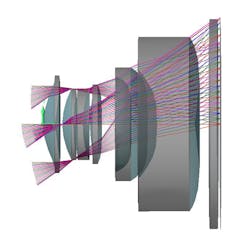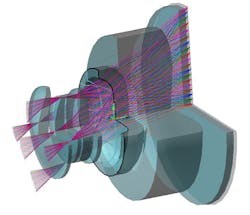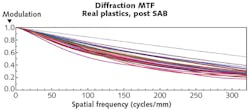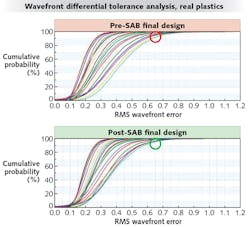Optical Design Software: Design for manufacturability in optical systems: In this case, perfection is the enemy
MATT NOVAK
Lens-design optimization can be challenging, and even more so when tolerancing and costs are taken into account. Optimization towards a solution that is nominally perfect is often not the best approach. In fact, perfect nominal performance can be the enemy of other very good solutions that have less sensitivity to manufacturing errors. This article describes techniques to reduce the impact of fabrication and assembly tolerances as part of the optimization process. Such techniques lead to more functional design forms that meet performance requirements while minimizing manufacturing costs, increasing production yields and often leading to faster time-to-market. This ultimately leads to more successful production designs.
Cost consciousness: important for high-volume optics manufacturing
It is always important to be aware of costs when creating an optical design meant for production hardware. The importance increases dramatically when the design is destined for production in high volumes (numbers in the several hundreds of thousands to millions of units per production interval).
Some items to consider that influence system cost include:
- Materials selection (glasses, plastics, and low- and high-dispersion materials for refractive designs)
- Number of elements in the design
- Reflective vs. refractive design forms
- Mounting and packaging constraints
- Mass constraints
- Fabrication method (traditional grind and polish, CNC generation, molding, etc.)
In addition to these considerations, there is another (often overlooked) influence on system cost. This is something designers have control over early in the design process and is worth highlighting: the sensitivity of the design to fabrication and alignment errors, and the influence this has on the yield (the as-built performance).
Growing importance of as-built performance as a quality metric
Early in the computer lens-design era, optimization for the best nominal performance was a common practice. No matter which optimization method or software was used to do the job, each designer would generally try to target the smallest image spot, or lowest root mean square (RMS) wavefront error for each field point optimized for the design. As time went on, methods to create tolerance-insensitive designs were explored and evidence of this appeared in optical design literature.1-3
The importance of designing for improved as-built performance has risen, as high-volume optics manufacturing has come to the forefront in many industries and applications. Consider the ubiquity of compact camera modules in security, automotive, consumer electronics, medical, and other applications, which has driven demand and use of many high-volume manufacture designs.
FIGURE 1. This example f/2.0 compact camera lens is composed of molded plastic elements.
Example high-volume system: compact aspheric camera lens
Here, some techniques are presented for reducing the sensitivity of a design to manufacturing tolerances in the context of lenses designed for high-volume manufacture. Mobile device lens designs are increasingly compact and rely on several higher-order aspheric surfaces to achieve excellent image quality (see Fig. 1).
The tolerances for such a lens are exacting, just as performance requirements are more demanding based on consumer expectations. This type of lens provides remarkable imaging, considering the small package required. The modulation transfer function (MTF) for this example design is shown in Figure 2.
FIGURE 2. MTF curves are shown for the example compact camera lens design, with tolerance insensitivity.
Improved as-built performance: useful design techniques
As previously mentioned, rather than aiming for the best possible nominal performance, the best as-built performance is the more important goal, especially in high-volume manufacturing. This is illustrated for a common lens design metric—as-built RMS wavefront error (see Fig. 3).
How should a designer go about achieving better as-built performance? Although making use of design software tailored to meet the needs of design for tolerance insensitivity is highly recommended,4 there are several points to consider, independent of the software used to perform the optical design. Keeping these in mind will reduce design sensitivity and lead to improved yield.
FIGURE 3. This plot illustrates metrics of as-built performance vs. nominal design performance (optimization error function).
Traditional design techniques to reduce lens design sensitivity include:
- Dividing optical power across multiple surfaces
- Using higher-index (glass or plastic) materials where possible
- Reducing local surface curvatures as much as possible
- Controlling ray angles of incidence directly with optimization constraints
Modern considerations for aspheric surface representations indicate use of additional techniques:
- Using specialized error function controls in design software
- Using a strong global optimization method, such as Global Synthesis in Synopsys’ CODE V optical-design software, to find inherently insensitive design forms
- Minimizing high-order aspheric terms
- Considering local surface slopes (control for high slope errors, remove inflection points)
- Considering mid-spatial frequency errors (fabrication method-dependent)
Result: improved production yield and significant cost savings
The importance of high-yield designs for manufacture cannot be overstated. As an illustration, consider aspheric optical systems in mobile devices, which are manufactured in high volumes for consumer electronics.
To place some hypothetical numbers on cost savings resulting from improved yield, a brief survey of camera costs of a well-known mobile phone manufacturer was performed. To arrive at an estimate of potential cost savings, a per-day sales volume of 550,000 units and a cost per camera module of approximately $20 were assumed. These data points are not verified, but reflects common publicly published data for mobile device manufacturers and their reported sales. For illustrative purposes, assume that all lost yield for camera modules is transferred to scrap.
FIGURE 4. These cumulative probability charts show how the design for tolerance insensitivity results in improvements to the as-built predicted performance (from red to green circle, the increase in yield is evident).
As can be seen in the cumulative probability charts in Figure 4, when optimizing for design insensitivity using Synopsys’ CODE V optical design software and its built-in sensitivity error function, an improved predicted yield enhancement of approximately 3% is seen, given a relatively complex design space. Translating this to production savings in production (assuming scrap for all lost yield as mentioned and production costs of 1/10 pricelist cost), this means the manufacturing process will send ~18,000 fewer lenses per day to scrap. This results in approximately $36,000/day production savings. Even though these are hypothetical results, the illustration is relevant to anyone working in the design of optics for high-volume manufacturing.
REFERENCES
1. M. Isshiki, L. Gardner, and G. G. Gregory, “Automated control of manufacturing sensitivity during optimization,” SPIE Optical Systems Design Conference, St. Etienne, France (2003).
2. J. P. McGuire, Jr., “Designing Easily Manufactured Lenses Using a Global Method,” International Optical Design Conference, Proc. SPIE, 6342 (2006).
3. A. Epple and H. Wang, “Design to Manufacture from the Perspective of Optical Design and Fabrication,” OSA Frontiers in Optics (2008).
4. See www.synopsys.com/optical-solutions/codev.html.
Matt Novak, Ph.D., is CODE V senior staff applications engineer in the Optical Solutions Group at Synopsys, Mountain View, CA; e-mail: [email protected]; www.synopsys.com.





